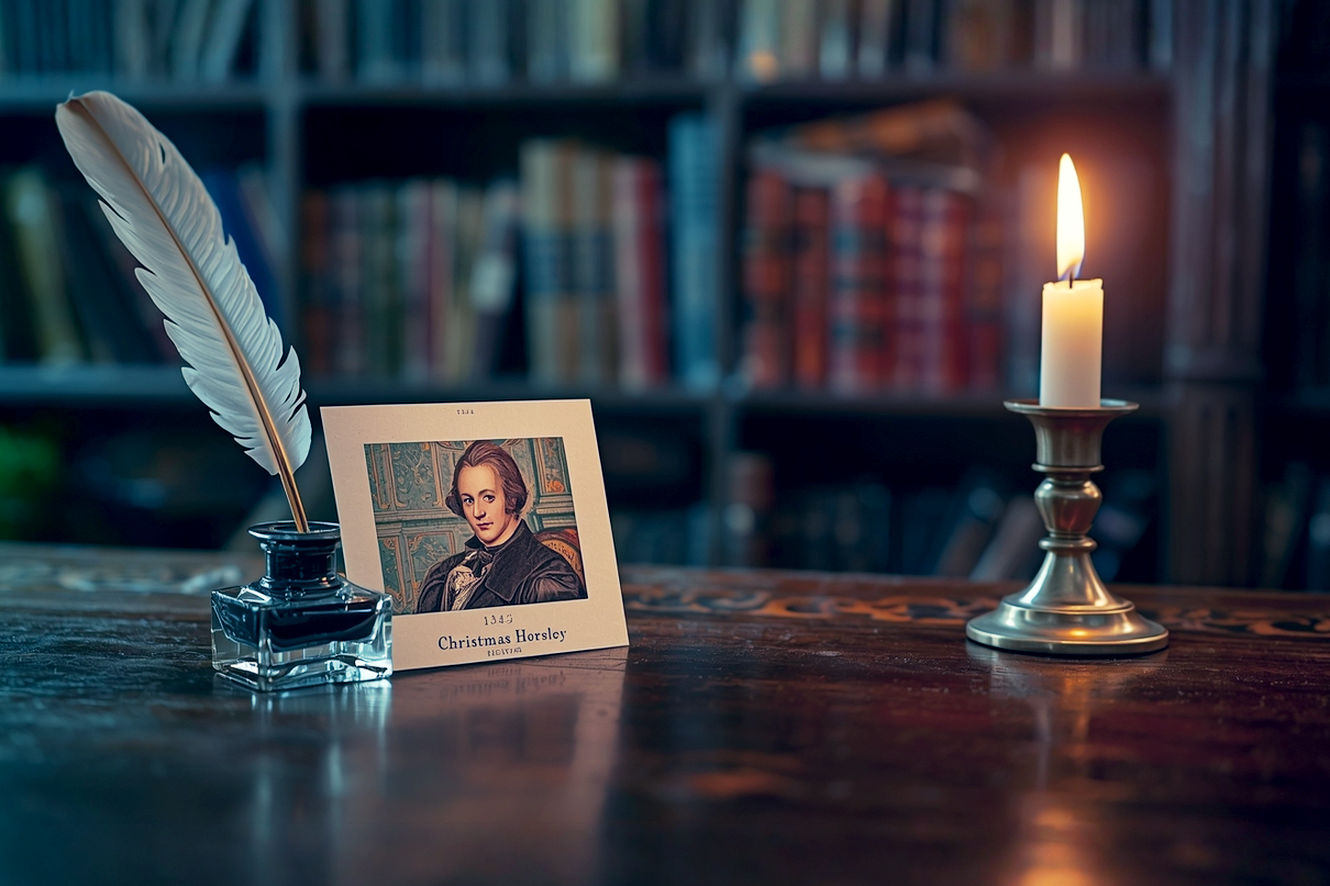This post may contain affiliate links. If you make a purchase through these links, we may earn a commission at no additional cost to you.
It’s a sound as essential to the festive season as sleigh bells and carols: the sharp, satisfying CRACK! that echoes around the Christmas dinner table. It’s the prelude to a collective groan at a terrible joke, the ceremonial donning of a flimsy paper crown, and the discovery of a tiny, often baffling, plastic trinket. The Christmas cracker is a cornerstone of holiday celebrations, particularly in the United Kingdom and Commonwealth nations—a delightful, slightly absurd ritual that unites generations in a moment of shared silliness.
But have you ever stopped, paper hat slightly askew, to wonder where this bizarre tradition came from? Who decided that a festive meal required a small, controlled explosion?
The story isn’t one of ancient folklore or age-old custom. Instead, it’s a tale of Victorian ingenuity, Parisian romance, and entrepreneurial grit. It’s the story of a London confectioner named Tom Smith, a man who took a simple French sweet and, with a spark of inspiration from a crackling fireplace, transformed it into one of the world’s most enduring festive novelties. This is the definitive history of how a simple desire to sell more sweets ignited a global tradition, one snap at a time.
The World Before the Cracker: A Sweet Tooth and a French Fancy
To understand the cracker’s origin, we must first step into early Victorian London. It was a city of dramatic contrasts, of industrial smoke and burgeoning wealth. For the growing middle class, life was changing. The 1840s and 1850s saw the popularization of many traditions we now consider quintessentially “Christmas,” thanks in no small part to Queen Victoria, Prince Albert, and the writings of Charles Dickens. The Christmas tree, greeting cards, and elaborate family feasts were all becoming central to the holiday.
Amidst this festive evolution, London had a burgeoning sweet tooth. Confectionery shops, once the preserve of the wealthy, were becoming more common. One such establishment was run by Tom Smith. Born in 1823, Smith was a baker and confectioner in Clerkenwell, East London, specializing in sweets and wedding cakes. He was a craftsman and an entrepreneur, always on the lookout for the next big thing.
His search for innovation led him on a trip to Paris in 1847. There, he encountered a local delight that would change the course of his career: the French bon-bon.
This wasn’t a chocolate or a truffle. The French bon-bon was a simple sugared almond or other small sweet, wrapped in a twist of colored tissue paper. Crucially, many of these bon-bons also contained a small slip of paper printed with a sentimental or romantic motto—a “kiss” in written form. They were popular as love tokens, a sweet and charming gesture exchanged between admirers.
Tom Smith saw potential. This was a novelty, a simple, elegant product that could capture the romantic imagination of the British public. He brought the idea back to London, confident he had a winner on his hands.
The Confectioner’s Spark: From Parisian Bon-Bon to English ‘Cosaque’
Back in his Clerkenwell workshop, Smith began producing his own version of the French treat. He replaced the almond with one of his own sweets and included a love motto, wrapping the package in a similar twist of paper. He initially called them ‘Cosaques’ (Cossacks). The name was likely an attempt to cash in on the public’s fascination with the fierce Russian Cossack soldiers, whose galloping and gunfire were frequently in the news. The name was meant to evoke a sense of excitement and a “crack” of a whip or rifle.
The ‘Cosaques’ sold reasonably well, especially during the Christmas season. People bought them as stocking fillers and party favors. But they weren’t a runaway success. The novelty was charming, but it was also fleeting. Once the Christmas rush was over, sales would plummet. For a man with ambition like Tom Smith, this wasn’t enough. He needed something to make his product stand out, to give it a unique identity and year-round appeal.
He experimented. He created elaborate wrappers and hired artists to design them. He expanded his range of mottoes from simple love notes to riddles, jokes, and witty sayings. Sales improved, but he still hadn’t found the game-changing ingredient he was looking for.
The breakthrough, as the story goes, came not in his workshop but in the comfort of his own home. One evening, likely around 1860, Smith was sitting before his hearth, enjoying the warmth of a crackling log fire. As he watched the flames, a log suddenly shifted, throwing out a shower of sparks with a loud CRACK!
In that instant, inspiration struck. It was a true “eureka” moment.
What if his ‘Cosaques’ could do that? What if they could open with a bang, a pop, a moment of startling excitement that would delight and surprise his customers? The name ‘Cosaque’ already hinted at a bang; now he just needed to deliver on the promise.
From a Whisper to a Bang: The Invention of the “Snap”
The idea was brilliant, but the execution was a significant technical challenge. How could he create a safe, reliable “bang” in a simple paper tube? Gunpowder was far too dangerous and impractical. He needed a mechanism that was stable enough for packaging and transport but would react predictably when pulled.
Smith, and later his son Walter, began experimenting with chemistry. They eventually landed on a compound called silver fulminate.
A Quick Lesson in Chemistry: How the “Snap” Works
- Simplified Explanation: Think of the snap inside a cracker as being like a tiny, self-contained firework. It uses a chemical that explodes with a “crack” sound when you create friction, just like striking a match. The friction is created when you and a partner pull the two ends of the cracker, causing the two parts of the snap to rub against each other.
- Detailed Explanation: The cracker snap consists of two narrow, overlapping strips of cardboard, with a minuscule amount of silver fulminate (AgCNO) and an abrasive (like sand or ground glass) painted onto them at the point of contact. Silver fulminate is a primary explosive, meaning it’s highly sensitive to friction, impact, and heat. When the cracker is pulled, the friction between the two strips of card is enough to detonate the silver fulminate. The resulting rapid decomposition of the chemical creates a small, supersonic shockwave, which we hear as the distinctive “crack.” The amount used is incredibly small—just enough to make a noise and perhaps a tiny, harmless spark, but not enough to pose any real danger.
Perfecting this mechanism took time and effort. Smith had to find the right chemical formula, the right amount to use, and a way to mass-produce the snaps safely. But once he did, he knew he had transformed his product. He initially marketed his new, improved creations as the ‘Bangs of Expectation’. It was a descriptive, if slightly clunky, name. Eventually, the product settled on the simpler, more evocative name that would stick: the Christmas Cracker.
The public was enchanted. The addition of the snap turned a simple confection into an interactive experience. It was no longer just a treat; it was a piece of parlor entertainment. Sales soared, and Tom Smith’s factory was soon struggling to keep up with demand.
Building a Better Cracker: The Evolution of a Festive Icon
The invention of the snap secured the cracker’s place in the market, but the innovation didn’t stop there. Tom Smith was a shrewd businessman, and as his sons—Tom Jr., Walter, and Henry—joined the family business, they brought new ideas that would cement the cracker as an unshakeable tradition. The competition was growing, and to stay ahead, Tom Smith & Co. needed to offer more than just a bang and a sweet.
The Addition of the Paper Hat
It was Walter Smith, Tom’s son, who is credited with introducing the paper hat. This wasn’t just a random whim; it was a stroke of marketing genius that tapped into deep-rooted traditions. The paper crown is believed to be a nod to the ancient Roman festival of Saturnalia, a winter solstice celebration where social hierarchies were temporarily overturned. During Saturnalia, a “Lord of Misrule” or “King for a Day” was chosen, often by lot, and would wear a crown and preside over the festivities.
This tradition was echoed in Britain’s own Twelfth Night celebrations (the evening of January 5th), which historically marked the end of the Christmas season. A special cake was baked with a bean and a pea hidden inside. The man who found the bean in his slice became King for the night, and the woman who found the pea became Queen. They, too, would wear paper crowns.
By placing a paper hat inside the cracker, Walter Smith was linking his product to these ancient rituals of festive misrule and temporary status elevation. It added a layer of performance and silliness to the cracker-pulling ceremony. Suddenly, everyone at the table, from the patriarch to the youngest child, could be a king or queen for a moment.
The Trinket and the Terrible Joke
The original love mottoes and simple sweets soon felt outdated. The Smiths realized that the element of surprise was a key part of the cracker’s appeal. What hidden treasure would be revealed when the cracker was pulled?
The sweets were gradually replaced by small, mysterious gifts or trinkets. Early gifts were often made of metal or porcelain—items like tiny dolls, whistles, costume jewelry, or miniature figurines. The quality and variety of these gifts became a major selling point and a way to differentiate their products from competitors.
At the same time, the romantic mottoes evolved into the groan-worthy jokes and riddles we know today. Why are they so famously bad? It’s part of the charm. The terrible puns act as a social leveler; they are universally, democratically unfunny. Sharing a collective groan is as much a bonding experience as sharing a laugh. The joke ensures that even if the gift is a disappointment, the cracker still delivers a shared moment.
With these additions, the holy trinity of the Christmas cracker was complete: the hat, the gift, and the joke.
Themed Crackers for Every Occasion
The Smith family’s marketing acumen was remarkable. They understood that the cracker’s appeal could extend far beyond Christmas. They began designing and producing specialty crackers for almost every conceivable occasion and demographic.
There were crackers for:
- Bachelors and Spinsters: Containing items like false teeth and wedding rings.
- War Heroes and Military Events: With miniature lead soldiers or patriotic symbols.
- Coronations and Royal Jubilees: Featuring regal designs and commemorative gifts.
- Political Movements: Remarkably, they even produced crackers for the Suffragettes, containing political messages and slogans.
- Luxury Markets: The “Millionaire’s Cracker” might contain a solid silver gift, while others were designed for specific interests, like motoring or travel.
This diversification ensured that Tom Smith & Co. dominated the market. They weren’t just selling a Christmas product; they were selling a customizable celebratory device.
Cracking the Market: How Tom Smith & Co. Conquered Christmas
The cracker’s rise was perfectly timed. It slotted neatly into the cultural landscape of the late Victorian era, an age that idealized the family and romanticized the Christmas season.
The Victorian Christmas Zeitgeist
The cracker was the perfect parlor game for a society that valued domestic entertainment. It was interactive, family-friendly, and provided a moment of structured fun during the long, often formal, Christmas dinner. It was a product that aligned perfectly with the values promoted by Queen Victoria and Charles Dickens: family togetherness, festive cheer, and a touch of childlike wonder.
The Royal Seal of Approval
The ultimate endorsement for any Victorian brand was the approval of the Royal Family. Tom Smith & Co. actively sought this validation, and their success was a testament to their quality and reputation. The company was awarded its first Royal Warrant by the Prince of Wales (later King Edward VII) in the late 19th century.
This was a marketing coup. A Royal Warrant signified that the company was an official supplier to the Royal Household. It was a seal of quality and prestige that instantly elevated the brand above all competitors. The company has held Royal Warrants from reigning monarchs ever since, including from Queen Elizabeth II, cementing its status as “the official cracker.” The slogan “By Appointment to Her Majesty the Queen” became a powerful symbol of the brand’s heritage and excellence.
Global Expansion and the American Anomaly
As the British Empire expanded, so did its traditions. The Christmas cracker traveled with British expatriates, soldiers, and administrators to the far corners of the globe. Today, it remains a beloved tradition in Canada, Australia, New Zealand, and South Africa.
Yet, there is one place where the cracker has never truly caught on: the United States. This remains a curious cultural anomaly. Several theories attempt to explain it:
- Different Holiday Traditions: American Christmas celebrations evolved with different influences, particularly from German and Dutch immigrants. The boisterous, game-oriented British Christmas dinner wasn’t as central.
- Safety Concerns: In a more litigious culture, a product containing a small explosive, however harmless, may have been viewed with more suspicion or faced regulatory hurdles.
- Lack of a Cultural Foothold: Without the backing of a tradition like Twelfth Night or the endorsement of a “royal family,” the cracker may have simply been seen as a strange and frivolous British import.
While you can certainly find Christmas crackers in specialty shops across the U.S. today, they remain a niche product, a fun curiosity rather than an essential part of the holiday fabric.
The Enduring Crackle: The Christmas Cracker in the 21st Century
Over 160 years after Tom Smith was inspired by his fireplace, his invention is more popular than ever. But the modern cracker faces modern challenges.
The Environmental Debate
In an age of increasing environmental awareness, the traditional cracker has come under scrutiny. The single-use plastic toys, the glitter, the metallic paper, and the sheer volume of waste generated have led to calls for a more sustainable alternative. Many consumers are no longer comfortable with the “throwaway” nature of the product.
The Rise of Sustainable and Luxury Crackers
The market has responded to this criticism with innovation, just as the Smith family did a century ago.
- Eco-Friendly Crackers: Many companies now offer crackers made from recycled paper, printed with vegetable-based inks, and tied with natural twine. The plastic gifts are being replaced with more sustainable alternatives like seeds, metal or wooden puzzles, or charitable donations.
- DIY Cracker Kits: For the crafty and conscious consumer, “do-it-yourself” kits allow families to create their own crackers, filling them with personalized gifts and jokes.
- Luxury Crackers: At the other end of the spectrum, the luxury market has exploded. High-end department stores and designer brands sell opulent crackers containing everything from silver cufflinks and designer perfume to fine chocolates and bottles of gin. For these consumers, the cracker is a status symbol, a way to add a touch of extravagance to the festive table.
A Legacy of Connection
The Christmas cracker has survived and thrived because its true function goes far beyond its physical contents. The hat is flimsy, the joke is terrible, and the gift is often forgotten by Boxing Day. But that’s not the point.
The cracker is a ritual. It’s an icebreaker. It’s a device that forces everyone at the table, from shy teenagers to grumpy uncles, to connect. It requires partnership—you can’t pull a cracker alone. It mandates a moment of shared, silly fun, briefly interrupting the formality of the meal.
Tom Smith didn’t just invent a novelty toy. He invented a mechanism for connection. He bottled a moment of surprise and delight and wrapped it in festive paper. He took a simple sweet and, with a spark of genius, created a tradition that has brought families and friends together for generations, all starting with one, glorious CRACK!






